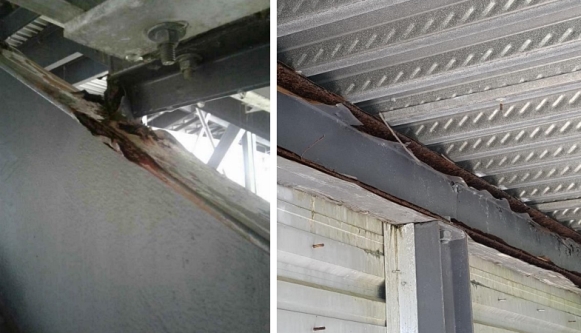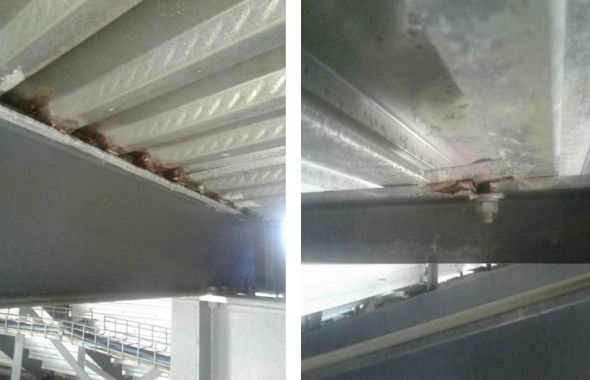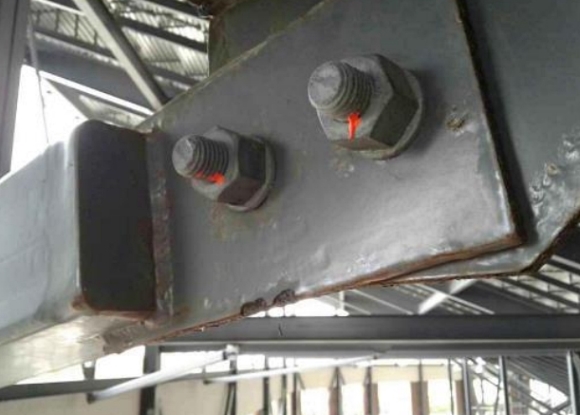Spectrum Stadium opened in 2007 as the new home of the football team at University of Central Florida (UCF) (Orlando, Florida, USA), and shortly thereafter it became unofficially known as “The Bounce House,” because the stadium would vibrate and shake when fans jumped in unison.1
Upon further review, however, the questions regarding structural integrity were flagged as more substantial than just a temporary phenomenon due to excited football fans.
In a study2 commissioned by UCF earlier this year, regional engineering consultants TLC Engineering for Architecture, Inc. (Orlando, Florida, USA) and Consulex (Cocoa, Florida, USA) found widespread corrosion on steel framing had caused significant damage to the structure over its first 10 years—allegedly from poorly coated steel.
“Although much of the visible corrosion is surface corrosion associated with the weakest areas in the coating system, there are also localized corrosion hot spots that are exhibiting significant loss of metal section thickness,” the engineers write in the 480-page report. “Left unabated, this presents a significant risk of undermining the structural integrity of the stadium framing.”
Louis G. MacDowell III, a NACE International-certified Protective Coating Specialist, led the final preparation of the report by the investigative team, which was prepared for TLC Engineering and UCF’s director of facilities, planning, and construction.
Findings at the Stadium
According to the report, completed in August 2017, corrosion affected more than 80,000 ft2 (7,432 m2) of the stadium. Four stairways had heavily rusted supports and potential for “significant section loss,” while areas of the stadium's fireproofing were graded as “failing” due to cracks and corrosion. In all, engineers documented more than 1,600 hot spots that exhibited significant levels of corrosion or failure of a protective coating on the steel beams. Rust was visible in 5.5% of the tested areas.

“Corrosion undercutting of the coating due to incorrect coating selection was the most prominent issue observed at the stadium,” the engineers wrote in the report. “The progression of the corrosion damage started with pinpoint rusting or blistering of the coating from the effects of moisture contacting the surface. This progressed to undercutting and lifting of the film that allowed more moisture to make contact with the underlying steel.”
The university says it immediately began making repairs to the most severely damaged areas to protect fans during the 2017 football season, though it did not specify exactly what or where those repairs were. Regardless, further work is likely necessary in the years ahead, the report notes.
UCF’s board of trustees filed a lawsuit in September 2017 with the Orange County Circuit Court against the stadium’s architects and contractors, alleging construction defects.
“The stadium is safe,” UCF spokesman Chad Binette says. “We are dealing with long-term repair and remediation issues, and our lawsuit is about assigning those costs. Any urgent needs have been addressed. Engineers evaluated the stadium before the season, as takes place every year, and found it to be safe.”
Problems with Initial Coating System
While specifications for the original coating job were not available, the engineers say lab analysis found the original coating to be a polyester urethane powder system.
“With very little, if any, primer coating applied as part of the system, the durability and corrosion resistance of the system is marginal at best,” the engineers write. “These urethane powder systems are usually specified for light duty environments, not an extended life span as expected at Spectrum Stadium.”
In addition, lack of proper surface preparation led to widespread coating delaminations, and improper coating application techniques resulted in thicknesses that were insufficient to protect the substrate.

“Newly manufactured steel typically has a very thin layer of mill scale on the surface,” the engineers write. “In the presence of moisture, the steel under the mill scale will corrode to protect the mill scale. Properly conducted surface preparation techniques will remove mill scale and prevent this type of corrosive attack.”
The inspection also found that a lack of stripe coats on the ends and edges of the structural members led to an early breakdown of the coating system. Specifically, areas of inadequate coating thickness allowed moisture to penetrate and start the corrosion process.
“Stripe coating provides extra thickness and protection at ends and edges, and as a result, significantly extends the life of the coating system,” the engineers say. “It can only be concluded that the coating processes used on this project were substandard and have led to many of the problems.”
A lack of coating inspection and quality control during the initial construction process was cited as a major factor in the level of deterioration. In addition to the coating flaws, several stadium locations also showed a tendency to collect and retain water, due partly to a lack of drain holes and a lack of caulking on the connections to prevent moisture intrusion. That water initiated crevice corrosion.
The use of disinfectant bleach for cleaning also harmed the facility, according to the engineers, who advised UCF to identify a noncorrosive cleaning and disinfection agent to be used for future cleaning operations. The chloride level in many corrosion areas was found to be greater than 100 ppm—and according to the investigators, corrosion grades for those areas were generally higher than other areas due to the presence of chlorides accelerating the corrosion attack.

Recommended Solutions
Moving forward, in contrast to the original urethane powder coating system, the engineers recommended two potential paths for stadium developers to consider in the months and years ahead.
“From a corrosion protection and maintenance reduction viewpoint, the optimum replacement coating would be an inorganic zinc system,” the engineers write, adding that abrasive blasting would be necessary to properly prepare the surface to accept the new coating.
However, inorganic zinc exhibits a metal-like, matte finish appearance and would not provide the same uniform, glossy architectural finish as the existing system, they warn.
“Inorganic zinc can be topcoated with decorative finishes, but concealing the zinc surface with another coating dramatically reduces its efficacy,” the engineers say. “Therefore, to utilize and fully benefit from this option, the aesthetics of exposed inorganic zinc would need to be architecturally acceptable.”
Another approach would be a spot repair and overcoat procedure.
“This would be more finite and include spot repair of localized corrosion hot spots, and then high-pressure water cleaning of the entire structure to remove failing and poorly adhered coatings,” the engineers write. “The entire structure would then be overcoated to restore uniform appearance and provide a barrier coat for added protection to potentially extend the life of the existing coatings.” Overcoat material choices could include epoxy/urethane systems and water-based elastomeric, metal-type coatings, according to the report.
To keep the stadium operational during football seasons, the engineers are advising UCF to consider a four-year plan completed primarily during the off months of February through July.
“It is Consulex’s recommendation that immediate spot repair methods be implemented for the most highly corroded areas to halt structural damage, and then a phased program of remove/replace with inorganic zinc by stadium quadrants over a four-year period,” the engineers write. “This strategy would provide the highest level of corrective action, the lowest level of future maintenance potential, and the most manageable expense over the long-term.”
The cost of the most comprehensive plan could approach $14 million, according to the report. That would represent roughly a quarter of the original $54 million investment for the stadium, which seats ~45,000 spectators. However, the engineers say the comprehensive solution should provide a high-performance coating system that prevents any further structural deterioration for 20 or more years.
Source: TLC Engineering, www.tlc-engineers.com; UCF, www.ucf.edu. Contact Chad Binette, UCF—email: Chad.Binette@ucf.edu.
References
1 “Spectrum Stadium,” Wikipedia, the free encyclopedia, https://en.wikipedia.org/wiki/Spectrum_Stadium (Nov. 7, 2017).
2 “UCF Spectrum Football Stadium Structural Steel Rust Remediation Report,” TLC Engineering for Architecture, Inc., Sept. 28, 2017.